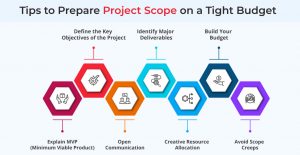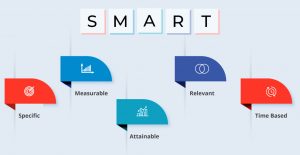
Every project manager desires flawless project execution devoid of delays and cost overruns. But the truth is far different. Have you ever failed to complete a project owing to budgetary issues? Tight budgets frequently result in constraints, including less room for scope growth, limited resources, and the inability to extend the project schedule.
A project budget establishes the financial parameters for cost management. Learn how to create a project’s scope on a tight budget. Every endeavor incurs expenses. The larger and more complicated a project is, the more time and money it requires to complete. Due to the fact that no organization has unlimited resources, every project requires a budget.
The difficulty, though, is that it is only sometimes effortless to determine how much money a project will require throughout its life cycle. If you underestimate what is necessary, you will be short on personnel and unable to execute the job on time. On the other hand, if projections are excessively high, the entire project may be abandoned. So how do you choose the appropriate project scope for project management? First, let’s examine the procedure in detail. But before that, let us discuss what a Project Scope is.
What is Project Scope?
The project scope includes the requirements to achieve project goals and objectives and prevent scope creep. Project scope is a method for setting project limits and defining what objectives, dates, and deliverables will be pursued. Effective scope management involves strong communication. It ensures that all team members comprehend the project’s scope and agree on the precise means by which its objectives will be achieved.
As part of scope management, the team leader should request permissions and signatures from stakeholders as the project progresses to ensure that the final product fits everyone’s requirements. By defining the scope of your project, you can ensure that your goals and objectives are met without delay or extra effort.
Defining the scope of your project is more than just a one-person job. Rather, you should align with key project stakeholders and ensure everyone agrees. For instance, if you’re working on a product marketing launch, you’ll want to ensure that you’re aligned with appropriate corporate teams, such as the product, design, and content teams. Depending on your project’s complication, you may also need to establish a change management procedure.
What is a Project Scope Statement?
A project management strategy is essential for ensuring that teams execute their task on schedule and according to specifications. Before project managers can design a detailed strategy, a project team can execute that plan. First, however, everyone must understand what work must be completed and why it is essential.
It is when the statement of project scope comes into play. A project scope statement explains the tasks that must be completed to complete a project on itinerary and within budget constraints. In addition, if you’re working with an external agency or team, you can convert your project scope statement into (SOW), a statement of work to formalize your agreement with your vendor.
The Benefits of a Project Scope Statement
According to the Project Management Institute, an effective project scope statement possesses several essential criteria. First, it ought to:
- Define the project’s boundaries
- Define the business need and anticipated project outcome
- Identify restrictions that limit the possibilities available to a project team when building a solution
- Include assumptions regarding decisions beyond the control of the project team
- Determine which business processes are affected by the project
- Determine which internal and external entities the project team will interact with
The project scope statement attempts to eliminate ambiguity by outlining the scope and ensuring that all key stakeholders are on board with the project and thoroughly understand it. So, if you have a strong procedure, there will be fewer requests for modifications. If you can accomplish this, your chances of success significantly increase.
As with all project management papers, the project scope statement may have a similar format across projects. But it should also be adaptable based on the project’s size, scope, and complexity. These variables will also influence the types of stakeholders who must be involved in the development and reception of the project scope statement.
Tips to Prepare Project Scope on a Tight Budget
Explain MVP (Minimum Viable Product)
When you know that a client has a limited budget, establish the project’s scope at the beginning so that the client and team are aligned on expectations and have a thorough understanding of what must be delivered. It means that the project team and stakeholders devote sufficient time to understand the product’s requirements and demands comprehensively. To effectively manage project deliverables within the budget and timeframe specified, the first step is to ensure those project requirements are appropriately recognized, recorded, and agreed upon with client stakeholders.
Define the Key Objectives of the Project
Once project managers have an understanding of the organization’s goals; they must identify the project’s precise objectives. The objectives should specify why the project is being undertaken, what will be accomplished, when it will be accomplished, and how much it will cost. In other words, the objectives describe and justify why executives selected and funded a certain initiative. Objectives should be formulated in accordance with SMART goal-setting principles, i.e., they should be specific, measurable, attainable, relevant, and time-based.
Why?
SMART gives a framework for establishing goals and objectives. They monitor task execution and, as a result, increase team efficiency.
What are these SMART objectives that have the ability to alleviate so many planning problems? SMART goals for this purpose are comprised of the following criteria:
- Specific – the objective is clearly stated
- Measurable – metrics exist or can be created to establish when the objective has been met
- Attainable – the team agrees the objective is realistic
- Relevant – the purpose fits the organization’s strategic plan and holds up the project charter
- Time-based – a date or time for achieving the objective is stated. Objectives without target dates are merely dreams.
Open Communication
As the project manager, it is their responsibility to ensure that both the team and the client know and agree with all project choices. Creating a Gantt chart and identifying milestones can assist bring internal and external teams into sync. Additionally, regular agile team meetings and stakeholder/client meetings will be essential for maintaining open lines of communication and keeping everyone informed.
Project managers must give weekly executive reports containing this information to ensure that client stakeholders know the project’s status, key updates, risks or roadblocks, mitigation plans, and future events/meetings.
Identify Major Deliverables
Project managers should associate with key stakeholders to create a list of the deliverables after the project. These things can be stated at a high level in the project scope statement. For instance, a new market evaluation report or a new software feature — but they should still be concrete and measurable objectives. The precise actions connected with a particular deliverable will be outlined in a work detail structure document. One approach to recall the difference is that deliverables are typically nouns and adjectives, whereas work details are verbs.
Creative Resource Allocation
One of the biggest barriers to a project with a tight budget is that set requirements cannot be assigned even if the project requires additional resources to expedite the timeframe for project deliverables. As a result, when deadlines are tight and the scope appears less attainable, the existing team must work longer hours to fulfill the dates. As a competent project manager, you want to prevent your team from becoming overworked and exhausted.
To avoid this problem, you can be resourceful when assigning team members to the project. For example, you can ask for the content and product designer’s deliverables. When that is conducted, they are allocated at 50% capacity or removed from the project. In addition, it freed up some funds to allocate a test engineer at 50% capacity to the team to expedite the testing process.
To make adequate use of the project budget, it is essential that project managers regularly examine the number of people working on the project and forecast the allocation requirements as frequently as feasible.
Build Your Budget
Once you have exhausted the list of required project resources, you may proceed. You’ll have your estimations. Don’t forget to add an emergency fund to your budget. For instance, all line items relating to training, such as printing expenditures for training materials, should be grouped together in a training bucket.
As part of developing your budget, you should document any underlying assumptions. It is essential because, after a project begins, some assumptions may hold while others do not, resulting in variance between actual project costs and the budget.
By documenting the assumptions, it will become clear why the budget did not match reality.
Include a timeline if the budget spans a substantial amount of time — often more than a month. It enables recurring expenses to be identified in the budget. In addition, it helps you anticipate when certain fees will arise.
Finally, discuss the budget with other team members to receive comments. The second pair of eyes can spot missing goods and verify the accuracy of numbers by reviewing the budget. It also helps you avoid budgeting errors prior to approval requests.
Avoid Scope Creeps
Scope creep, according to the PMBOK Guide, is the uncontrolled increase of a project’s scope without corresponding modifications to time, cost, or resources. Nearly fifty percent of projects undergo scope creep, only 57 percent are completed within budget, and 51 percent are completed on time.
Moreover, almost all projects experience scope creep at some point, and under favorable conditions, it is sometimes simple to rein in scope creep.
However, with a constrained budget, there is no room for scope expansion. Therefore, it is extremely important that the project scope is constantly under control and that neither the project team nor the client asks for more features, functions, or requirements. The project manager can prevent scope creep by continuously evaluating the MVP, the agreed-upon feature list, and the Gantt Chart with the client and the team.
Conclusion
Did you know that roughly 71% of all projects fail, with 55% of those failures attributable to budget overruns? Budgeting for a project is a necessary skill for everyone in a company. Remember that your first project budget will be the most difficult to create. However, once you have mastered this procedure, your planning efforts will accelerate, and your projects will consistently be completed within your budget. Suppose you want to deliver a low-budget project on time effectively. In that case, you must constantly analyze the project’s budget, anticipate the required resources, and communicate freely with your team and customer.
A master’s certification in project management is one option to gain professional-level project management knowledge and skills. In addition to building a project scope statement, you will also learn how to engage with executives and project sponsors and practice using soft skills to manage teams. And prepare to assume increased responsibilities by managing a larger team and a larger budget.
So, explore our Project Management program website to learn how an advanced degree can help you enhance your career in project management.






















